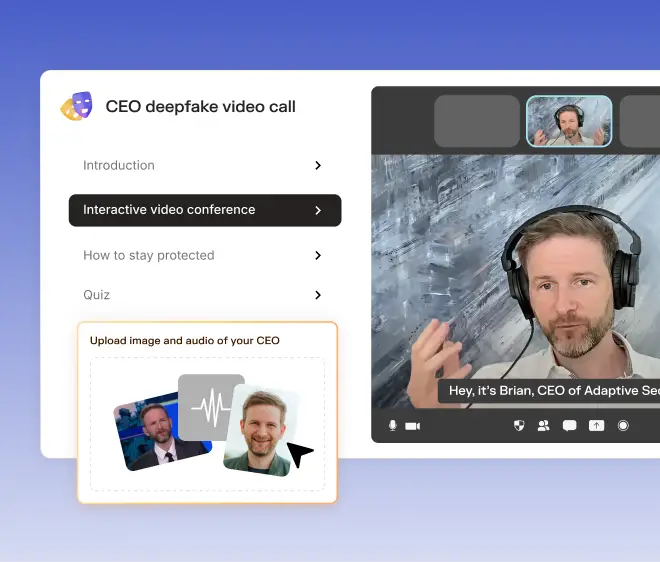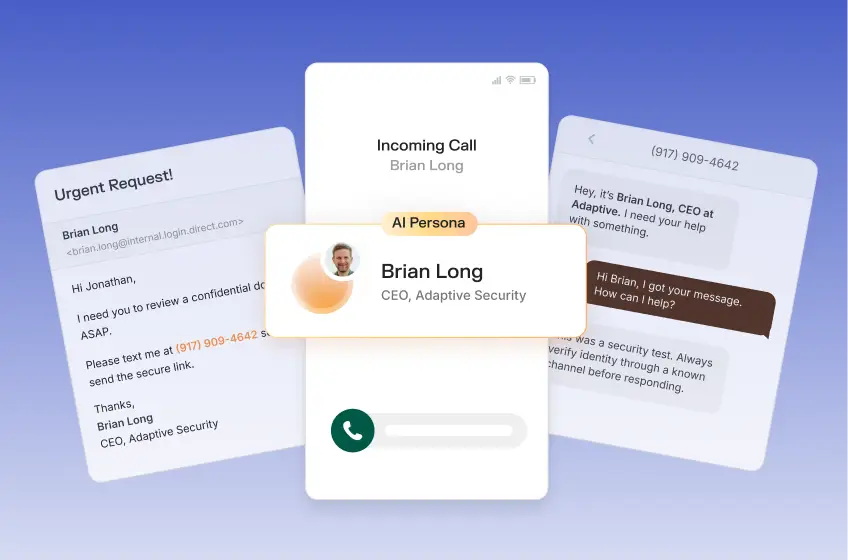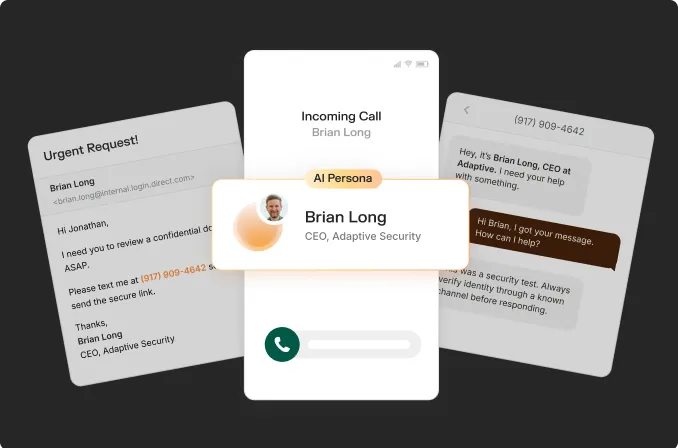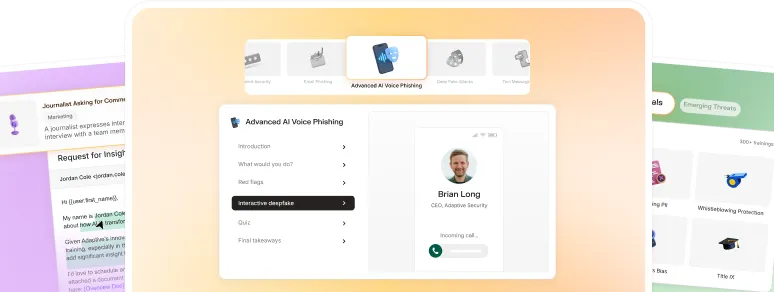Every second, attackers make another move to steal your login credentials. In 2024, Microsoft reported that organizations face 7,000 password attacks per second worldwide. That sheer volume explains why credential phishing—emails or messages designed to trick you into handing over usernames and passwords—remains one of the most common and costly security problems.
Employees are the No. 1 entry point for these attacks. Whether it’s clicking a link, entering credentials on a fake page, or trusting a spoofed message, human actions are often what make or break a breach attempt. Attackers don’t need sophisticated malware when they can exploit behavior, and if you or your team aren’t prepared to spot the signs, those attacks succeed.
In this article, you’ll learn exactly how credential phishing works, see real-world examples of its impact, and walk away with practical steps to protect yourself and your organization.
What is credential phishing?
Credential phishing is a type of cyberattack that tricks people into giving away login details like usernames, passwords, or multi-factor authentication (MFA) codes. Unlike broader phishing, which may spread malware or push fraudulent payments, this type focuses only on stealing credentials that unlock valuable systems.
Hackers often go after the online accounts with the widest reach: corporate email, cloud services, or banking portals. Once inside, they can move laterally, escalate privileges, or sell access to others. According to Verizon’s 2024 Data Breach Investigations Report, stolen credentials were involved in 31% of all breaches over the past decade, which shows why this method remains popular.
A simple example makes the risk clear. Imagine an email that looks like a cloud storage provider asking you to “verify your password.” The logo, colors, and tone all seem familiar. The link leads to a near-perfect login page, and the moment you type in your details, attackers capture them for immediate use.
Phishing succeeds because it exploits human behavior rather than technical vulnerabilities, making it difficult to stop with technology alone. People are busy, they trust familiar branding, and they often click quickly under pressure. That human factor makes credential scams one of the most persistent threats in security today.
How credential phishing works
Credential phishing attacks usually follow a clear process. Hackers send messages that look trustworthy, often with urgent language. The goal is to drive you to a counterfeit login page or to trick you into approving a request.
Once credentials are entered, they’re captured and used for unauthorized access. In many cases, this access is later exploited for data theft, fraud, or even ransomware deployment.

This image shows a phishing email pretending to be from a trusted service like OneDrive or payroll. It uses a suspicious “from” address, alerts you of a shared file, and asks you to click a link. Once you click, you’re on a fake page that captures your login details.
The methods differ but aim for the same outcome: credential theft.
- Email phishing: Attackers send messages that appear legitimate, such as fake login pages or password reset alerts. You might receive an urgent “Reset Your Password” notice, click the button, and then end up on a counterfeit website that captures your credentials.
- Spear phishing: These attacks go deeper. The email might reference a current project or a colleague’s name. For example, you might get a note from “HR” about your appraisal—only it’s a mimicked address designed to fool you into entering your credentials.
- Deepfake and genAI-enhanced attacks: Now, attackers use AI tools to clone voices or write messages in tones that resemble your manager or a vendor. You might then get a voice message asking you to confirm access details. The familiarity and realism increase your likelihood of complying.
- Social media / direct message phishing: Think of a fake LinkedIn DM from a “recruiter” offering a role or “urgent” documents. You click the link, log in, and unknowingly hand over access to your corporate or personal accounts.
5 simple steps to stay safe against credential phishing
- Use a password manager with single sign-on (SSO) to fill credentials securely.
- Enable MFA everywhere possible and pair it with firewall and endpoint controls for added protection.
- Avoid clicking malicious links in unsolicited messages; many phishing campaigns aim to take over accounts or exploit exposed APIs.
- Verify requests through another trusted channel and leverage threat intelligence feeds to confirm legitimacy before acting.
- Report anything suspicious so security teams can apply automation and machine learning to detect patterns and block future attempts.
Real-world examples of credential phishing
Credential phishing has made headlines in recent years since it affects every type of organization. From property management to biotech to hospitality, attackers use simple tricks to trigger costly outcomes. These three cases show how different industries were hit and why the consequences matter.
Property firm loses $19M to a single email
In early 2025, Milford Entities, a luxury property management company in New York, wired nearly $19 million to criminals. Staff received a phishing email impersonating the Battery Park City Authority and followed instructions to transfer funds to a fraudulent account. What seemed like a routine request turned into a devastating loss.
Business impact:
- The firm lost a significant portion of its available capital.
- Operations and cash flow were thrown into crisis.
- News coverage damaged confidence among tenants and partners.
Gmail law-enforcement spoof
Threat actors in 2025 sent Gmail users fake subpoenas that appeared to come from a law enforcement agency. The emails used Google Sites to host a login page that captured user credentials.
Business impact:
- Users lost access to email accounts and sensitive information.
- Companies using Gmail experienced account lockouts.
- Google had to restrict certain site functions and increase safeguards.
Hotel staff tricked by fake booking alerts
Later in 2025, attackers targeted hotel employees with emails that appeared to come from Expedia or Cloudbeds. Subject lines mentioned urgent new bookings or system updates. Staff clicked through, entered details on fake login pages, and unknowingly gave away their credentials and even MFA codes.
Business impact:
- Guest management systems were disrupted during busy check-in periods.
- Compromised accounts allowed attackers deeper access into operations.
- IT teams scrambled to reset credentials and reinforce email defenses.
Fake Okta websites
In 2025, researchers found that cybercriminals were using generative AI tools to create fake login portals that appeared identical to Okta’s authentication page. These clones could be launched in under a minute, making it easier than ever for attackers to scale phishing campaigns.
Business impact:
- Employees struggled to distinguish fake websites from legitimate ones.
- Security teams faced a flood of convincing phishing domains.
- Organizations began exploring passwordless authentication and brand-monitoring tools.
Tools and techniques for credential phishing prevention
Technical defenses give you the first line of protection. Google reported in 2024 that Gmail’s AI-powered filters block 15 billion phishing emails daily, preventing more than 99.9% from reaching inboxes. This shows why filtering is essential, but also why you need layered defenses.
Email filtering and authentication
Start by strengthening how email is handled. Filtering solutions combined with industry standards help verify that messages truly come from the domains they claim. This makes impersonation far harder to pull off.
Key protocols include:
- Domain-Based Message Authentication, Reporting, and Conformance (DMARC): Aligns SPF and DKIM checks and instructs receiving servers to block, quarantine, or allow messages that fail.
- Sender Policy Framework (SPF): Confirms whether an email is sent from an IP address authorized by the domain’s administrators.
- DomainKeys Identified Mail (DKIM): Uses encrypted signatures in the email header so the recipient can verify that the message has not been altered in transit.
When these standards are configured properly, a phishing email pretending to be from your CEO or payroll system is far less likely to reach an inbox.
Password managers
A password manager reduces the risks of both weak and reused credentials. These tools also add a hidden benefit: they autofill logins only on legitimate websites. If a user clicks a phishing link and lands on a fake login page, the manager won’t provide any credentials. That pause is often enough to trigger suspicion and stop the attack.
Multi-factor authentication (MFA)
Adding a second factor of verification makes stolen passwords far less valuable. Even if an attacker captures a valid username and password, they still need the additional code or token.
The challenge is MFA fatigue, where attackers send repeated push requests, hoping someone approves one just to clear the notification. Training employees to spot and report fatigue attempts is as important as the technology itself.
Browser and endpoint protections
Not every phishing attempt gets blocked at the email layer, which is why device-level protection matters. Tools like browser isolation, real-time URL scanning, and endpoint detection and response can prevent a credential submission even if someone clicks. For example, an endpoint solution can block traffic to a known phishing site before any data leaves the device.
AI-driven anomaly detection
Artificial intelligence adds another safeguard by watching for unusual behavior. These systems learn what normal login patterns look like and flag suspicious deviations. If an account suddenly signs in from two countries within an hour, the system can lock the session or require new verification. This helps catch attacks that slip past other layers.
Bringing the layers together
No single measure can stop credential phishing on its own. But when you combine filtering, password managers, MFA, endpoint protections, and anomaly detection, you create overlapping defenses that both reduce risk and give IT teams more time to act.
Pro tip: Integrate your defenses so they talk to each other. For example, if anomaly detection flags an unusual login, you can trigger your single sign-on (SSO) provider to force step-up authentication and your endpoint tool to check the device health at the same time. You don’t just detect suspicious activity—you automatically contain it before it turns into full account takeover.
The role of security awareness training in preventing credential phishing
Even with strong technical defenses in place, phishing messages still find their way to inboxes. Attackers know that all it takes is one distracted click to bypass expensive security tools. That’s why employee readiness is just as important as email filtering or multi-factor authentication.
A single annual video or quiz may check the compliance box, but it doesn’t prepare people for today’s evolving attacks. Credential phishing has moved beyond clumsy spam. Employees now face sophisticated lures that mimic trusted brands, urgent HR notices, or even AI-generated voice messages. Without practice, it’s unrealistic to expect anyone to spot every trick.
This is where modern security awareness training (SAT) comes in. The most effective platforms go beyond generic reminders. They embed continuous, contextual learning into daily workflows, so people build habits rather than cram knowledge once a year.
Adaptive Security is a next-gen SAT and phishing simulations platform that takes this approach further. Its capabilities are designed specifically to address the modern phishing scam landscape:
- Advanced phishing simulations that mirror real-world tactics, including AI-enhanced attacks and deepfake impersonations
- High levels of customization that let security teams tailor simulations to industry-specific threats, company culture, and employee risk profiles
- Behavior-based training pathways that trigger automatically when risky behavior is detected, ensuring people learn in context
- Early detection of human risk signals, giving program owners measurable insights into progress and weak spots across departments
These features complement technical defenses by making employees an active part of prevention. They also deliver measurable improvements, helping security leaders prove ROI and justify investment.

Credential phishing is a human problem, and a solvable one
Credential phishing thrives because attackers exploit people, not just systems. Strong email filters, password managers, MFA, and anomaly detection reduce exposure. But technical defenses alone can’t remove the risk. The deciding factor is often whether an employee recognizes and reports a suspicious message.
That means the problem is deeply human—and that’s also where the solution lies. With the right training, people can learn to pause before clicking, verify requests through trusted channels, and report threats quickly. Continuous, behavior-driven security awareness programs turn phishing attempts into teachable moments, building resilience over time.
Adaptive Security helps you fortify your cybersecurity defenses with continuous training designed for today’s threats, not yesterday’s. Instead of one-off reminders, your employees get real-world practice that improves decision-making when it matters most.
Discover how Adaptive turns your employees into your strongest defense—book a demo today.
FAQs about credential phishing
How is credential phishing different from regular phishing?
General phishing aims to spread malware, collect credit card information, or trick users into fraudulent payments. Credential phishing focuses specifically on stealing login details such as usernames, passwords, or MFA tokens.
Credential phishing is especially dangerous because a single stolen login often gives attackers immediate access to email, cloud systems, and sensitive data.
Can MFA stop credential phishing?
MFA reduces the usefulness of stolen passwords, but it is not foolproof. Attackers increasingly use MFA fatigue tactics, bombarding users with repeated prompts until they approve one.
Phishing sites can also capture session tokens. MFA remains critical, but employees must know how to recognize and resist these tricks.
Are password managers safe from credential phishing?
Yes. Password managers block most phishing attempts by auto-filling credentials only on legitimate sites. If you open a fake login page, the tool won’t enter any details, giving you a clear warning. The main risk happens when users ignore the manager and type credentials manually. Use a password manager consistently and pair it with multi-factor authentication, and you gain strong protection against credential theft.
Can spear phishing happen via social media direct messages?
Yes. Attackers use platforms like LinkedIn, Slack, or WhatsApp to impersonate colleagues or recruiters. Messages may include urgent document requests or fake job opportunities that link to phishing pages. Social channels feel personal, which makes these lures harder to ignore without training and clear policies.
What’s the best phishing awareness and prevention tool?
The best defense combines technology with training. Filters, MFA, and password managers are essential, but they can’t stop every attack. For awareness and prevention, leading platforms include:
- Adaptive Security: advanced phishing simulations, high customization, continuous behavior-based training
- Cofense: strong phishing detection and reporting workflow.
- Proofpoint: enterprise-grade awareness campaigns
As phishing tactics evolve, Adaptive provides the edge—aligning training with AI-driven threats and building lasting resilience across the workforce.




We are a team of passionate technologists. Adaptive is building a platform that’s tailor-made for helping every company embrace this new era of technology without compromising on security.
Contents



Want to download an asset from our site?





%20(1).avif)


.avif)
%20(1).avif)
%20(1).avif)



